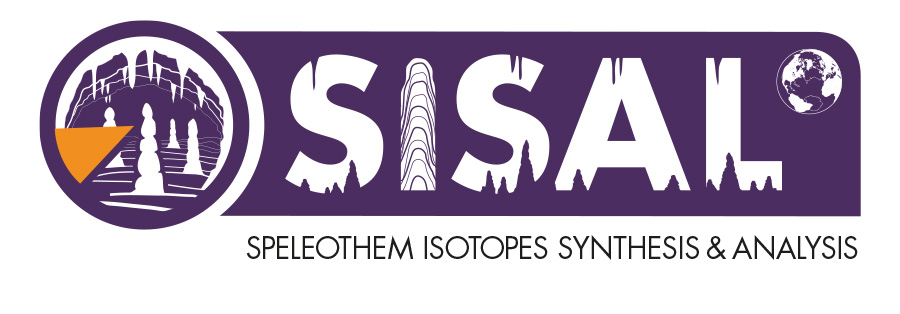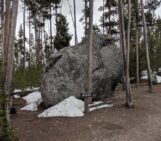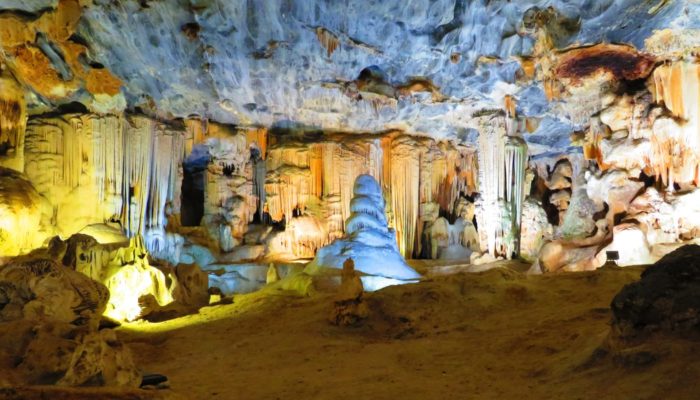
Reconstructing past climate states from geological records is crucial for understanding the causal mechanisms that originated them. These can occur at time-scales which are much longer than the periods for which humans have been measuring climate variables such as temperature in meteorological stations. Such climate reconstructions provide a long-term context to the magnitude of the current anthropogenic (man-made) climate change and are used to evaluate climate models that predict future climate states. For the past few decades, research groups have been reconstructing climate records from archives such as ice cores, marine sediment cores and cave deposits. In order to harness the potential of these individual records, it is necessary to collate, standardise and synthesize them into regional and/or global datasets. This blog post describes one such effort to synthesize global speleothem records to address ‘big picture’ climate questions.
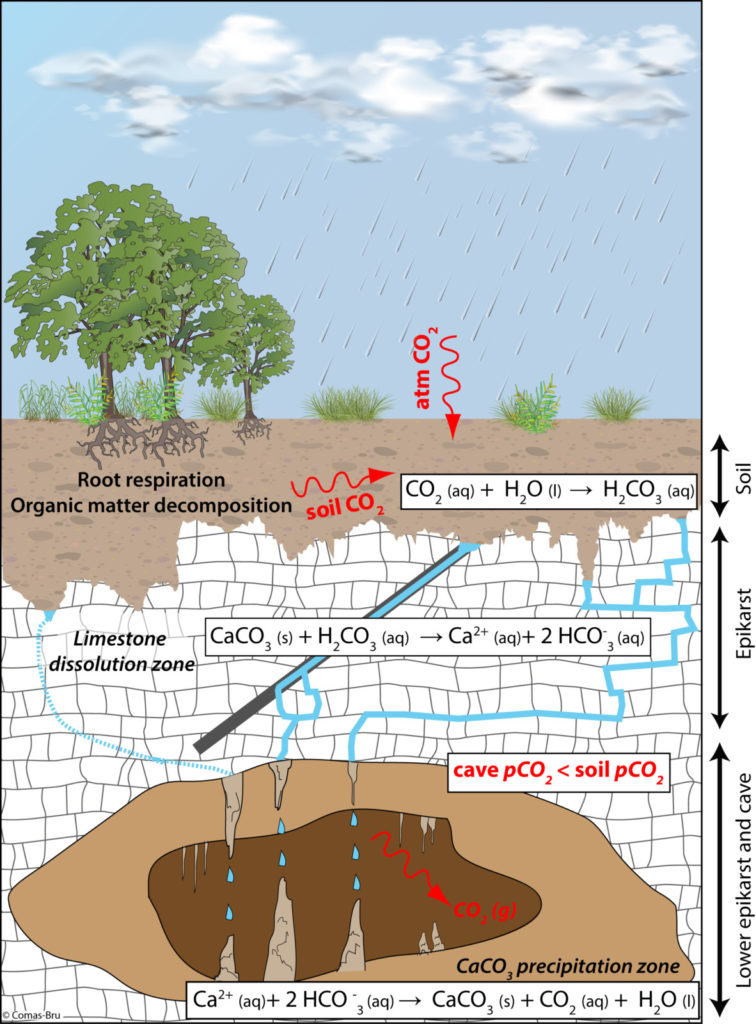
Figure 1: Schematic illustration showing the formation of speleothems. Rain water reacts with CO2 released from decaying plant matter to form a weak carbonic acid (H2CO3) in the soil. This weak carbonic acid is able to slowly dissolve carbonate rocks like limestone (CaCO3) as it flows through cracks and fissures in the rock. When this water reaches the cave, the excess CO2 is expelled triggering the reverse reaction and precipitating the carbonate as stalactites and stalagmites.
Speleothems (such as stalagmites) are inorganic cave deposits that form from drip waters super-saturated with respect to calcium carbonate (CaCO3) (Figure 1). This means that the waters cannot hold more calcium carbonate in dissolution and therefore it precipitates in form of calcite on the ceilings (stalactites) and floors (stalagmites) of caves. Speleothems are useful paleoclimate archives as they preserve aspects of the cave drip water geochemical composition and provide information of the overlying vegetation and soil and the climatic conditions influencing them. Speleothems can grow in a wide range of hydroclimate regimes and are distributed in continental karst regions around the world. Some speleothems grow in arid regions such as the Arabian peninsula and the Middle-East, or in cold regions such as Siberia. The major strength of speleothems is their suitability for accurate age determinations: dates up to c. 600,000 years can be measured with uranium-thorium technique and the uranium-lead method can be used for older ages. These methods use the radioactive decay chain of uranium to obtain an absolute date. The dates done with the uranium-thorium technique can have uncertainties of the order of 50 years for a sample that grew 11,700 years ago. This small uncertainty allows us to compare records and identify offsets between global climate events thereby increasing our understanding of climate dynamics. Speleothems can capture climate information at seasonal resolution although most records available have a decadal resolution (which means that, on average, they have one sample per decade). This allows researchers to study climate variability at different temporal scales.
The different types of measurements made on speleothems include the stable isotopes of oxygen and carbon (δ18O, δ13C) and various trace elements (Mg, Sr, U, etc.). While oxygen isotopes usually reflect regional scale circulation changes, carbon isotopes and trace elements usually provide information on local hydroclimate and vegetation. Significant past climate variations recorded in speleothems include shifts of the Intertropical Convergence Zone, glacial-interglacial transitions and millennial-scale variability of tropical atmospheric circulation and sub millennial-scale variability in response to polar warming episodes as well as climate-related migrations of humans out of Africa.
Although more than one thousand speleothem records have been published over the last decades (Figure 2), there have been only limited attempts to synthesise speleothem data globally and their degree of standardisation and/or the completeness of their metadata was limited. However, to accurately synthesise the available speleothem records such compilations ought to include enough metadata like as information on the age-models or the geology of the cave site, to facilitate quality control or cross-comparison of records. Such synthesis is best done by experienced researchers in speleothem science from different geographical regions to provide a quality product to be used for further research work. The SISAL working group (Speleothem Isotope Synthesis and Analysis) launched in 2017 under the auspices of Past Global Changes (PAGES) to create a systematic global compilation of speleothem isotope data. SISAL has published the first compilation of speleothem data as well as a set of regional studies of past climate changes that are part of a Special Issue “Speleothems and Climate” in Quaternary. The regional review papers introduce the regional geography, climatology and the climatic interpretations of the speleothem oxygen isotopic records while highlighting gaps and future directions of research. In particular, they provide comprehensive information on the spatio-temporal distribution and temporal resolution of the speleothem records and critically examine the quality of the records based on current standards.
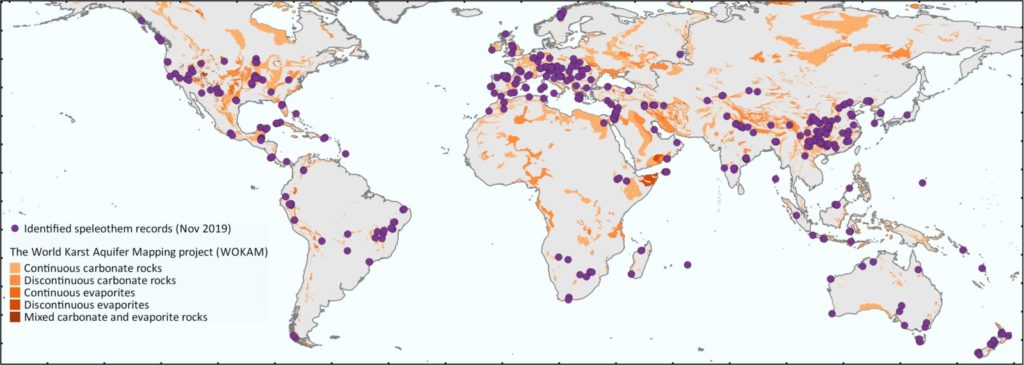
Figure 2: Location of the speleothem records identified by the SISAL working group. The base map shows the distribution of carbonate and evaporite rocks as provided by the World Karst Aquifer Mapping project (WOKAM; Chen et al., 2017).
Additionally, the community-endorsed metadata in SISAL is an important first step towards providing guidelines on what information needs to be made available for scrutiny, verifiability, re-use, and re-purposing of speleothem data since this is increasingly required by funding agencies in support of open science in line with the FAIR (Findable, Accessible, Interoperable, Reusable) principles for scientific management and stewardship, also supported by the European Geosciences Union.
Climate change is a key challenge facing society today and palaeoclimate records provide an independent test of models used to predict future climate. Speleothems provide one of the few data sources that can test models’ ability to capture decadal to millennial climate variability, but they have not been used systematically yet (e.g. only 7 speleothems are included in the standard benchmark dataset used for the evaluation of palaeoclimate models; Harrison et al., 2014). Therefore, to increase the visibility and impact of speleothem research, the SISAL working group has also worked towards providing a protocol for using speleothem data to evaluate isotope-enabled palaeoclimate simulations in the framework of the Coupled Model Intercomparison Project Phase 6. In this study, the SISAL community showed that the database reproduces the first-order spatial patterns of isotopic variability in the modern day, strongly supporting the application of this dataset for evaluating model-derived isotope variability into the past. However, the discontinuous nature of many speleothem records complicates procuring large numbers of records if data-model comparisons are made using the traditional approach of comparing anomalies between a given palaeoclimate experiment and a control period. To circumvent this issue, we illustrated some novel approaches to use absolute isotope values for model evaluation.
SISAL is the first global database of speleothem data containing a comprehensive array of metadata to allow quality control and reliability assessment of the records and it will significantly contribute to expand the geographical availability of palaeodata, thereby improving the reliability of the data-assimilation techniques used in model evaluation. In addition, the SISAL database will allow for many scientific questions to be addressed by providing easy access to all speleothem data currently available, which in turn increases the visibility and impact of speleothem research. Some examples of studies that can be done using the SISAL database include detecting anthropogenic forcing in speleothem records and, investigating the timing and geographical extent of the Medieval Climate Anomaly (MCA) and the Little Ice Age (LIA) periods, as well as the strength of the forcing signal.
REFERENCES Atsawawaranunt, K., Comas-Bru, L., Amirnezhad Mozhdehi, S., Deininger, M., Harrison, S. P., Baker, A., Boyd, M., Kaushal, N., Ahmad, S. M., Ait Brahim, Y., Arienzo, M., Bajo, P., Braun, K., Burstyn, Y., Chawchai, S., Duan, W., Hatvani, I. G., Hu, J., Kern, Z., Labuhn, I., Lachniet, M., Lechleitner, F. A., Lorrey, A., Pérez-Mejías, C., Pickering, R., Scroxton, N., and Members, S. W. G.: The SISAL database: a global resource to document oxygen and carbon isotope records from speleothems, Earth Syst. Sci. Data, 10, 1687-1713, https://doi.org/10.5194/essd-10-1687-2018, 2018. Bolliet, T., Brockmann, P., Masson-Delmotte, V., Bassinot, F., Daux, V., Genty, D., Landais, A., Lavrieux, M., Michel, E., Ortega, P., Risi, C., Roche, D. M., Vimeux, F., and Waelbroeck, C.: Water and carbon stable isotope records from natural archives: a new database and interactive online platform for data browsing, visualizing and downloading, Climate of the Past, 12, 1693-1719, https://doi.org/10.5194/cp-12-1693-2016, 2016. Burstyn, Y., Martrat, B., Lopez, J. F., Iriarte, E., Jacobson, M. J., Lone, M. A., and Deininger, M.: Speleothems from the Middle East: An Example of Water Limited Environments in the SISAL Database, Quaternary, 2, 16, 2019. Braun, K., Nehme, C., Pickering, R., Rogerson, M. and Scroxton, N.: A window into Africa’s past hydroclimates: The SISAL_V1 database contribution. Quaternary, 2(1), p.4, 2019. Cai, Y., Zhang, H., Cheng, H., An, Z., Lawrence Edwards, R., Wang, X., Tan, L., Liang, F., Wang, J., Kelly, M., Edwards, R. L., Wang, X., Tan, L., Liang, F., Wang, J., and Kelly, M.: The Holocene Indian monsoon variability over the southern Tibetan Plateau and its teleconnections, Earth and Planetary Science Letters, 335-336, 135-144, 10.1016/j.epsl.2012.04.035, 2012. Chen, Z., Auler, A. S., Bakalowicz, M., Drew, D., Griger, F., Hartmann, J., Jiang, G., Moosdorf, N., Richts, A., Stevanovic, Z., Veni, G., and Goldscheider, N.: The World Karst Aquifer Mapping project: concept, mapping procedure and map of Europe, Hydrogeology Journal, 25, 771-785, https://doi.org/10.1007/s10040-016-1519-3, 2017. Cheng, H., Edwards, R. L., Sinha, A., Spötl, C., Yi, L., Chen, S., Kelly, M., Kathayat, G., Wang, X., Li, X., Kong, X., Wang, Y., Ning, Y., and Zhang, H.: The Asian monsoon over the past 640, 000 years and ice age terminations, Nature, 534, 640-646, 10.1038/nature18591, 2016. Comas-Bru, L., Harrison, S. P., Werner, M., Rehfeld, K., Scroxton, N., Veiga-Pires, C., and members, S. w. g.: Evaluating model outputs using integrated global speleothem records of climate change since the last glacial, Clim. Past, 15, 1557-1579, 10.5194/cp-15-1557-2019, 2019. Fankhauser, A., McDermott, F., and Fleitmann, D.: Episodic speleothem deposition tracks the terrestrial impact of millennial-scale last glacial climate variability in SW Ireland, Quaternary Science Reviews, 152, 104-117, 10.1016/j.quascirev.2016.09.019, 2016. Harrison, S. P., Bartlein, P. J., Brewer, S., Prentice, I. C., Boyd, M., Hessler, I., Holmgren, K., Izumi, K., and Willis, K.: Climate model benchmarking with glacial and mid-Holocene climates, Climate Dynamics, 43, 671-688, https://doi.org/10.1007/s00382-013-1922-6, 2014. Shah, A. M., Morrill, C., Gille, E. P., Gross, W. S., Anderson, D. M., Bauer, B. A., Buckner, R., and Hartman, M.: Global Speleothem Oxygen Isotope Measurements Since the Last Glacial Maximum, Dataset Papers in Geosciences, 2013, 9, https://doi.org/10.7167/2013/548048, 2013. Genty, D., Blamart D., Ouahdi R., Gilmour M., Baker A., Jouzel J., and Van-Exter S.: Precise dating of Dansgaard–Oeschger climate oscillations in western Europe from stalagmite data. Nature, 421, 6925: 833, https://doi.org/10.1038/nature01391. Vaks, A., Bar-Matthews, M., Ayalon, A., Matthews, A., Halicz, L., and Frumkin, A.: Desert speleothems reveal climatic window for African exodus of early modern humans, Geology, 35, 831-834, 10.1130/G23794A.1, 2007. Vaks, A., Bar-Matthews, M., Ayalon, A., Matthews, A., and Frumkin, A.: Pliocene–Pleistocene palaeoclimate reconstruction from Ashalim Cave speleothems, Negev Desert, Israel, Geological Society, London, Special Publications, 466, 201-216, 10.1144/sp466.10, 2018. Vaks, A., Gutareva, O. S., Breitenbach, S. F. M., Avirmed, E., Mason, A. J., Thomas, A. L., Osinzev, A. V., Kononov, A. M., and Henderson, G. M.: Speleothems Reveal 500,000-Year History of Siberian Permafrost, Science, 340, 183-186, https://doi.org/10.1126/science.1228729, 2013. Wilkinson, M. D., Dumontier, M., Aalbersberg, I. J., Appleton, G., Axton, M., Baak, A., Blomberg, N., Boiten, J.-W., da Silva Santos, L. B., Bourne, P. E., Bouwman, J., Brookes, A. J., Clark, T., Crosas, M., Dillo, I., Dumon, O., Edmunds, S., Evelo, C. T., Finkers, R., Gonzalez-Beltran, A., Gray, A. J. G., Groth, P., Goble, C., Grethe, J. S., Heringa, J., ’t Hoen, P. A. C., Hooft, R., Kuhn, T., Kok, R., Kok, J., Lusher, S. J., Martone, M. E., Mons, A., Packer, A. L., Persson, B., Rocca-Serra, P., Roos, M., van Schaik, R., Sansone, S.-A., Schultes, E., Sengstag, T., Slater, T., Strawn, G., Swertz, M. A., Thompson, M., van der Lei, J., van Mulligen, E., Velterop, J., Waagmeester, A., Wittenburg, P., Wolstencroft, K., Zhao, J., and Mons, B.: The FAIR Guiding Principles for scientific data management and stewardship, Scientific Data, 3, 160018, 10.1038/sdata.2016.18, 2016.

